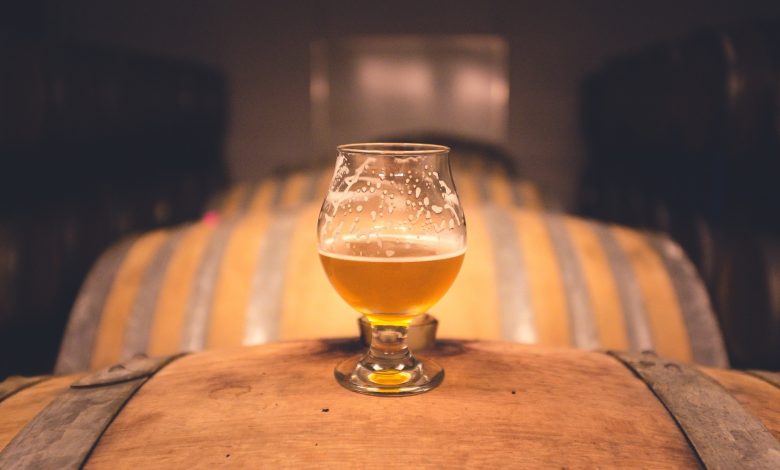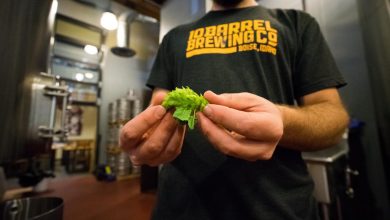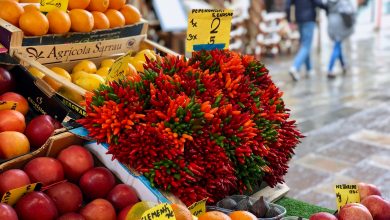Know Your Yeasts: The Types Of Yeasts Used To Brew Beer

Yeast plays an important role in beer making. It is yeast that gives each beer its distinct flavor profile. The presence of yeast is also what makes beers nutritious. In fact, for many brewers, the strain of yeast is a secret ingredient that makes their brand of beer distinct.
The simplest way to describe yeast’s role in beer-making is to say that it makes the fermentation process happen, which actually leads to the formation of beers. But it is important to understand some key aspects of beer-making that happen before and during fermentation and how yeast cells contribute to the processes therein.
It is only with this understanding that one can realize the depth of the role of yeasts in beer brewing. It would be fascinating to know that it is the humble and the most underrated yeast that gives each beer its style, history, and legacy.

What is Yeast?
Yeast falls into the category of a single-celled microorganism. It reproduces by budding, a process in which new yeast microorganisms develop from the outgrowths or buds on the body of the parent (mother cell). The function of yeast is to convert sugars into alcohol and other byproducts.
While there are over 500 strains of yeast, there are only two main types of yeast that need to be understood to realize the irreplaceable role that this microorganism plays in beer-making.
The two primary types of yeast are lager yeast and ale yeast. Before delving deeper into yeast types, it is important to know why yeast is important in beer brewing.
Role of Yeast in Beer-Making
One needs to know specific elements of a beer-making process to understand the role of yeast in beer brewing.
It all starts with wort.
Wort is a term used in brewery to refer to beer in its unfermented form. It is a liquid formed at the end of the mashing process. Mashing, in a brewer’s language, refers to the process of heating a combination of grains, predominantly malted barley, in hot water. Other supplementary grains that are added to the mix include wheat, sorghum, rye, and corn.
Mashing releases enzymes in the malt, which then act on the starch content in the grains. The enzymes convert the starch into sugars. Sugars are usually converted into maltose. The end product of mashing is a malty liquid, popularly known as wort.
Wort is important in the brewing process because it is this malty liquid that gives a beer its basic flavors. Depending on the ingredients, these flavors include the profiles of the grains and hops used in the concoction.
The wort is further refined through a process called lautering. This process eliminates grain husks and other solid particles in the original wort. The resulting liquid is clean, sugary wort.
The wort is then boiled to prevent the conversion of starch in the liquid to sugars. The liquid is then cooled. Yeast is then added to this cool mixture to initiate the process of fermentation.
During fermentation, yeast cells convert the sugars in wort into alcohol (ethyl alcohol) and carbon dioxide gas. Ethyl alcohol imparts alcoholic character to the beer, while the gas makes the beer carbonated.
Some key aspects of the fermentation process include:
- Yeast is added to a fermentation vessel. The wort is later introduced into this vessel.
- The mixture is maintained at different specific temperatures depending on the nature of the beer. If the beer is a lager, then the temperature is set at 48 degrees F for a period of six weeks. In case of an ale beer, the temperature setting is at 68 degrees F. The wort is maintained at this temperature for two weeks.
- The specific gravity of the mixture is measured periodically, starting at the time when wort is first added to the yeast. The measure of specific gravity gives the amount of alcohol in the beer. Once the specific gravity reaches the desired measure, fermentation is stopped.
- Beer produced through fermentation is then cooled. The cooling process helps the yeast to settle at the bottom of the vessel. Unwanted proteins are also a byproduct of this process. Cooling helps separate such proteins from the beer. Yeast used for fermentation is usually recycled for the next beer batch. This is possible because yeast settles at the bottom of the fermentation vessel toward the end of the process and is therefore easy to be isolated. Yeast is usually reused several times. When it starts mutating, meaning when its core properties start changing, then it is time to stop using the yeast. The yeast, at this stage, gives a different taste.

Yeast Byproducts Affect Beer Flavor Profile Too
The role of yeast in imparting flavor to beers is well-known. But the final flavor profile of a beer is a result of not only the yeast used to produce it but also the byproducts of the yeast.
Yeast produces byproducts during the process of fermentation and maturation. Maturation refers to the entire series of processes that takes place between primary fermentation and the point till yeast is removed.
Alcohol and carbon dioxide are of course the primary byproducts of yeast. Other byproducts that contribute to the final flavor profile of a beer include:
- Diacetyl – produces a buttery flavor
- Acetaldehyde – produces a green apple flavor
- Dimethyl Sulfide – imparts a flavor of cooked vegetables and sweet corn
- Ester – responsible for a fruity flavor reminiscent of fruits such as apples, strawberries, and bananas
- Clove – responsible for a spicy clove flavor
- Medicinal Compounds – imparts a phenolic or chemical flavor
- Sulfur – impart a flavor reminiscent of burnt matches or rotten eggs
- Solvents – impart an aroma similar to lacquer thinners
- Phenolic Compounds – impart an aroma similar to smoke, plastic, medicine, or cloves
Description of Yeast Types
Ale Yeast
Ale yeasts are also referred to as top-fermenting beers in brewing terminology. They are called top-fermenting because most of the fermentation process happens at the top of the fermenting vessel with these cells. Yeast cells travel upwards, towards the surface, during the fermentation process.
Temperature settings used for ale yeast fermentation usually range from 50 F to 77 F. Some strains of yeast in this category begin to ferment actively only at a temperature equal to, or greater than, 53.6 F.
This type of fermentation gives a thick yeast-rich beer. The top-fermenting process is the reason why ale beers are high in esters. The ester gives ale beer its distinctive character.
In addition to ales, top-fermenting yeasts are employed for brewing wheat beers, stouts, porters, Kolsch, and Altbier.
A highlight of ale yeast is its unique flavor, which makes it a preferred yeast variety for beer brewers. Unlike wild yeasts and bread yeast, ale yeast does not produce beers that taste phenolic. This is because ale yeast undergoes a natural mutation that prevents the yeast from imparting a phenolic flavor profile to beers.
In addition, the following benefits of ale yeasts make them a beer brewer’s favorite:
- Fermentation is faster with ale yeasts.
- They consume desirable sugars, which deliver beers with desired characteristics.
- They can withstand moderate levels of alcohol.
- They exhibit excellent tolerance to anaerobic (absence of oxygen) conditions during fermentation.
The top-fermentation process that ale yeasts typically undergo produces a healthy beer with rich yeast and little protein. There is also a disadvantage though. The top-fermentation process exposes yeast to the outer environment. This makes yeast cells vulnerable to contamination. If the fermentation environment is unhygienic, it contaminates the yeast cells.
Lager Yeast
Lager yeasts are also referred to as bottom-fermenting yeasts. This is because these yeast cells prefer to undergo fermentation at the bottom of the fermenting vessel. Lager yeasts do not require warmer temperatures as ale yeasts do for fermentation. They become active at 40 F, and can undergo fermentation at colder temperatures, usually in the range 50 – 55 F.
Lager yeasts can also undergo fermentation at temperatures reserved for ale yeasts, which results in a beer style called the California Common Beer.
Though lager yeasts undergo fermentation at the bottom of the fermenting vessel, they are not high flocculators (tendency of yeast cells to settle at the bottom of the fermenting vessel). A majority of lager yeast strains exhibit low to medium flocculation. These yeast cells remain in a suspended position, which helps decrease the levels of diacetyl and sulfur produced as a result of cold fermentation.
Lager yeasts produce fewer fusel alcohols and esters as a result of fermentation at colder temperatures. Lager yeast cells do not multiply as rapidly as ale yeasts, which decreases surface foam. The strain of lager yeast used and the fermentation temperature determine the final flavor profile of the beer.
Some examples of lager style beers include Dortmunders, Bocks, American Malt Liquors, and Pilsners.
Some benefits of lager yeast that make these cells popular for beer-brewing include:
- Lager yeast cells do not promote growth of bacteria and wild yeast. This is because lager yeast accepts colder temperatures for fermentation. This cold temperature range prevents the growth of bacteria and wild yeast.
- Lager yeast cells and lager beers have a longer shelf life. Lager beers are a great favorite of brewers, as they can be distributed over a wider geography, leading to increased sales.

Yeast Strains
The strain of yeast is extremely important because it determines the style of the beer.
There is a wide range of yeast strains, and each strain produces its own flavor profile. There are some Belgian strains that produce fruity esters during brewing, which results in beer flavors of cherries and bananas. The German yeast strains are known for producing phenols during brewing process, which results in a flavor profile that is similar to clove.
Major breweries come up with their own strains of yeast to enable production of unique beer formulations. The specialty of yeast strains is that they readily adapt to the conditions around them. So even if multiple breweries use the same strain of yeast, each can still produce a beer of a unique flavor!
More About Ale Yeast Strains
The number of strains of ale yeast is huge. Some popular examples of ale yeast strains include Belgian and wheat strains. Strains differ from one another on the basis of their performance. Performance features that contribute to the difference among ale yeast strains include:
Flocculation
Flocculation refers to the yeast cells’ tendency to settle at the bottom of the fermenting vessel toward the end of fermentation.
Flocculation reveals the unique tendency of single yeast cells to come together, form thousands of clumps, and reach the bottom of the fermenting vessel together.
As they travel toward the bottom of the vessel, clean and clear beer is left on the top.
Flocculation needs to be correctly timed for the beer to possess a desired flavor profile. If flocculation occurs way before time, then the resulting beer will be sweet and under-attenuated, meaning it will be less alcoholic and less dry.
If yeast cells do not undergo flocculation, the resulting beer will have a cloudy appearance and will carry a yeasty taste.
Ale yeast strains are capable of flocculation. They exhibit low, medium, or high flocculation. An example of a high flocculation ale strain is London/ English Ale strain. The American/California Ale strain shows medium flocculation. The Hefeweizen strain exhibits low flocculation.
Attenuation
Attenuation is a measure that indicates the amount of sugar that yeast has consumed during fermentation process. It is expressed in percentage. Attenuation plays a key role in informing brewers about the completion of fermentation.
This information is important because, if brewing continues even after completion of fermentation, then it compromises the quality and flavor profile of the beer.
With yeast cells that exhibit good flocculation properties, it is easy for the brewer to know when the fermentation is complete. The real problem begins when a brewer is brewing beer with yeast strains that show poor flocculation properties. In such cases, it becomes difficult for the brewer to know accurately when the fermentation has come to an end.
By measuring attenuation, brewers get to know the amount of sugar the yeast cells have consumed, which helps them determine if fermentation is complete.
Attenuation percentage depends on multiple factors including the yeast strain and fermentation conditions. Hence, attenuation is measured against the range specified for each yeast strain. The attenuation range specified for brewer’s yeast is 65 – 85%.

About Lager Yeast Strains
There are many commercially available lager yeast strains. Some popular strains include.
L13 Global – This strain produces a classic lager style beer. Beers possess a rich malty flavor. They are clean and have lower levels of sulfur and diacetyl. This strain has a slightly lower attenuation percentage. This means the yeast does not take consume sugars entirely; they leave back some sugars. L13 Global is known for imparting excellent malt character to beers.
L17 Harvest – This strain too is well-known for producing rich malty and clean beers. The strain has low attenuation levels, which is another reason for the rich malt nature of the beers produced from the strain.
Ale and Lager Yeast Forms
Ale and Lager yeasts usually come in 2 main forms – liquid and dry. Dry yeast cells are dehydrated strains. They are preferred for their storability. Before usage, dry yeasts are usually rehydrated.
A dry ale or lager yeast is best for a beginner brewer. This is because of the ease of availability and usage of dry yeast. Even a 7 gram pack of dry yeast packs in a lot of cells, and a majority of them are usable. A single or double pack (14 grams) of dry yeast cells is usually enough for a 5-gallon batch.
In addition, their longer shelf life enables beginner brewers to store them for use in the near future. So they do not lead to wastage or loss of money for the brewer.
Another benefit of dry ale or lager yeast is that it can be prepared quickly for brewing. A double pack of dry yeast cells is capable of producing active yeast cells sufficient to realize a strong fermentation. But the cells must be rehydrated properly to ensure successful results.
Though the shelf life of dry cells is long, they are still perishable. They can be stored in the refrigerator, but they degrade over time, especially if the pack was already old at the time of purchase. It is therefore important for brewers to buy their products from reputed sellers and manufacturers.
Though dry yeasts have a range of benefits, they do have their downsides. The dehydration process that these cells are subject to limits the range of ale strains in ale yeasts. In lager yeasts, dehydration thins down available yeast strains drastically, almost to the point of complete elimination.
These drawbacks are addressed by liquid ale and lager yeasts. The range of strains available to brewers in liquid yeast cells is more than that in dry cells. In addition, liquid yeasts are capable of imparting a unique flavor to beers.
Liquid yeast cells are available in foil pouches. A typical 50ml liquid yeast pouch does not usually contain as many cells as a dry pack has, though.
The yeast synthesis also takes time. Yeast cells from the pouch are added to a starter wort for yeast synthesis. This wort is maintained till the count of yeast cells reaches the required level. Larger pouches, typically weighing 175ml, are popular among brewers as they pack in cells that are enough to ensure strong fermentation of 5-gallon batch.
A knowledge of yeasts, their importance in beer brewing, and their types and forms, are crucial for brewers to choose the right type of yeast for their brewing process. It is only with the right selection of yeast that brewers can produce their signature beer.



